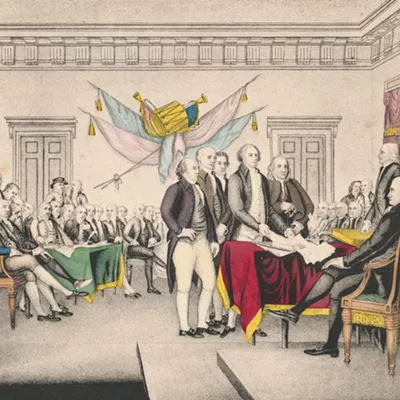Creeping Crawl -- Anyone who watches TV has seen "the crawl," that irritating scroll of words along the bottom of the screen. Previously reserved for vital breaking news, crawls have slunk into common usage for the most mundane things -- especially since 9/11, when some cable news channels added the permanent crawls to keep you distracted from what's going on at the top of the screen.
Thanks to KHQ (Channel 6) for demonstrating how low this can go: Three times in the middle of The West Wing, Q6 flashed a crawler about a small and isolated power outage in Spokane. Now, a crawler down the middle of the Weakest Link -- sure. But West Wing?
Worst of all, the crawl exhorted viewers (ostensibly those most affected) to stay tuned for breaking developments -- but if your power was out, how could you watch TV for breaking developments?
Hitting the Streets -- The Rising Times, a "street newspaper" covering Spokane's homeless population, has published a second issue. The sophomore hurdle is noteworthy given that the paper is the part-time effort of a couple of Gonzaga University students. And, of course, the paper's demographic isn't one most advertisers are clamoring to reach. The editors (including current Inlander editorial intern Leah Sottile) plan a third issue is for early next month.
1,600 -- The number of homeless people in Spokane at any one time, according to city social service estimates. The number for Kootenai County, Idaho, is estimated at 200 to 300.
Wildest West -- Seems like a bit of the Wild West, what with half a dozen bank robberies in Spokane since the New Year.
Last year, there were 38 bank robberies in the Inland Northwest (the seven northeast Washington counties covered by the FBI's Spokane office). That's a ratio of one robbery for every 14,000 people.
Robbers held up 40 banks in Tacoma/Pierce County, for a 1:17,500 ratio -- tamer than the Inland Northwest. But Seattle/King County's 144 robberies equal a ratio of 1:12,000.
Creating a Monster? -- Spokane County's property tax assessments follow market conditions less accurately in some areas than others, the Inlander reported last week. One reader called to tell us we'd pulled our punch a bit. Inequitable assessments were evidence that the assessor's office should be eliminated, perhaps through a citizen initiative, the dear reader said, adding, "Do you know how to start an initiative?"
No, but you might ask Tim Eyman. We hear his going rate is $150,000, give or take.


















